Building a word-rich life for Dyslexics
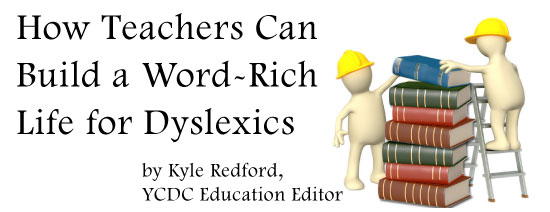
A confession: I get a significant thrill from reading research that confirms my personal suspicions. This happened recently when I dug into some studies about reading and achievement. According to the National Assessment of Educational Progress (NAEP), not only does the amount of reading “for fun” outside of school directly correlate to academic achievement, but there are numerous other studies to demonstrate that there is no better way to increase vocabulary than independent reading.
The NAEP study does not distinguish whether the higher achievement scores of students who read more reflected an increased exposure to more words or the specific act of decoding, but I would argue that it is the former. It is hard to imagine that the mechanics related to reading are responsible for these academic gains. We know that good thinkers need words, and reading is a gateway into the world of words and ideas. Therefore it would follow that how one gathers words is less important than how many words one gathers.
What does this mean for dyslexics?
Reading is harder and slower for dyslexic students. Consequently, they typically read less. If they are to keep up with their peers academically, then it is imperative to find additional ways to expose them to as many words and ideas as possible.
This is a challenge. Dyslexics often encounter a gap between their reading level and their intellectual level. This can turn them off of reading altogether. They don’t want to read “baby books”. Some handle this by faking engagement with thick sophisticated titles while others decide that they don’t like to read at all and avoid it completely. Both can be disastrous responses. Fortunately, there are a few tried and true tricks for building word power for elementary students with dyslexia.
Many Ways to Read
We all agree that children benefit from exposure to stories for their content, structure, and new vocabularies. But reading independently is not the only way to gain access to stories.
Read Aloud:
There are few things as powerful for encouraging a love of reading as a well-read story. This goes for all children. It is never too early to start reading books to children (and surprisingly, they are rarely too old to enjoy the act of being read to). In Naked Reading: Uncovering What Tweens Need to Become Lifelong Readers, Teri Lesesne cites Becoming a Nation of Readers, a study that was commissioned to examine reading in the United States, to make her own case for why teachers should not abandon reading to their classes once their students become independent readers. According to the study, reading aloud was the single most effective activity for building to eventual success in reading.
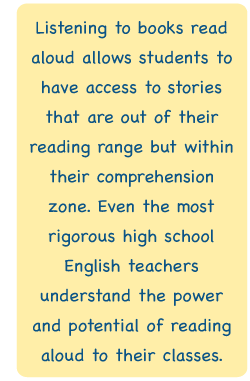
Listening to books read aloud allows students to have access to stories that are out of their reading range but within their comprehension zone. Even the most rigorous high school English teachers understand the power and potential of reading aloud to their classes. It also gives teachers an opportunity to model oral reading skills like fluency, proper pronounciation, and oral expression. These conditions serve all students, but they are critical to dyslexics. Dyslexics particularly benefit when they visually track with the reader as much as possible. “Reading along” gives the listening student an increased exposure to the look of words and makes explicit the process of converting letter combinations to sounds. In classrooms, using an “Elmo” gives the entire class a way to follow along with the text. In one-on-one situations, something as simple as sitting next to the child serves the same purpose.
Reading aloud also helps develop the building blocks of reading comprehension. Students are able to discover new vocabulary, formulate predictions, and make outside connections. When children are read to they usually ask questions. Their questions help to clarify what they are taking in and allow them to make meaning with someone else. It’s like having their own built-in book club. Having access to a discussion partner actually gives them an advantage over their silent-reading peers. Many more able readers will rip through stacks of books without pausing for reflection or questioning, thus reducing the potential for grasping many of the ideas or cultural/ literary references in the story. Students who are read to actually have a unique opportunity to discuss and question along the way.
Things to think about with read aloud:
Read aloud is powerful because of the opportunity to model reading fluency and expression. Consequently, the reader should be comfortable and familiar with the text. Previewing allows the adult reader to know the overarching architecture of the story and the personalities of the individual characters so that they can employ appropriate voice and tone. Also, many teachers confuse reading aloud with a round robin student read. Unfortunately, round robin reads are often very stressful for student readers (they obsess and rehearse their turn instead of listening to the story). It is also typically a choppy and fragmented version of the story and not effective for encouraging focus and engagement.
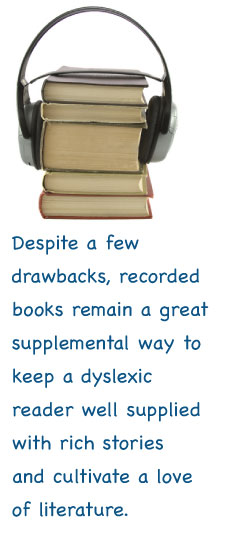 Recorded Books: Listening to audiobooks is a way to deliver words and ideas to a child with limited access to an adult reader. Recorded books are wonderful, particularly when authors or professional actors read them. Listening to stories being read aloud by master storytellers goes a long way to cultivate a love of literature. The drawbacks are that the child cannot ask questions or engage with the recorded storyteller and it is more difficult to follow along with the words. Additionally, recorded books also make it more difficult to maneuver around the pages (relocating a passage or a reference requires skill and patience). Despite these drawbacks, recorded books remain a great supplemental way to keep a dyslexic reader well supplied with rich stories.
Recorded Books: Listening to audiobooks is a way to deliver words and ideas to a child with limited access to an adult reader. Recorded books are wonderful, particularly when authors or professional actors read them. Listening to stories being read aloud by master storytellers goes a long way to cultivate a love of literature. The drawbacks are that the child cannot ask questions or engage with the recorded storyteller and it is more difficult to follow along with the words. Additionally, recorded books also make it more difficult to maneuver around the pages (relocating a passage or a reference requires skill and patience). Despite these drawbacks, recorded books remain a great supplemental way to keep a dyslexic reader well supplied with rich stories.
Vocabulary Building
Standardized tests, humanities teachers, and the culture at large reward those with a strong vocabulary. On a subtle level, vocabulary is often used as an unconscious gauge to determine someone’s level of intelligence. But much less subtly, having a strong working vocabulary helps one make meaning from the oral and written world.
It should be no surprise that dyslexic students struggle with written vocabulary. Often complex words are challenging because of difficult pronunciations. Dyslexic students may even know the written word when used in a context or read aloud, but on a written word list it means nothing. Teachers often deliver vocabulary in unimaginative and problematic ways, but the good news is there are many ways to supplement vocabulary instruction that will help every dyslexic child get more out of word studies.
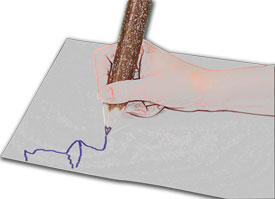 Illustrating New words:
Illustrating New words:
Vocabulary instruction is best when it involves having students draw a symbolic or realistic representation of the word. It requires them to make meaning from a word in a way that memorization of a definition does not. One can’t fake a picture. The first step in generating an illustration involves grasping the meaning or the context of the word. It doesn’t require artistic skill, but it does require thinking deeply. Creating the image also stores the word’s meaning in a different part of the brain, generating a visual association. Having students make pictorial flashcards can be a helpful strategy. Making a little drawing next to the word and its definition is another good practice.
Standardized Test Preparation:
Publishers of test prep books are starting to catch on to the power of imagery to create additional associations for memorizing words. There are many vocabulary book and flashcards available now that are organized around images and cartoons. These tools can be helpful for dyslexic students preparing for standardized tests.
Acting Out a Word:
Dyslexics also benefit from acting out words. Having to bring a word to life is a little like a game of charades. The beauty of the game is that it requires the actor to understand the word in a deep way. Acting out the meaning of a word is particularly helpful to a child who is a tactile learner (one who learns through using his body), but everyone benefits from creating additional associations for words.
Writing a story using vocabulary words:
It is amazing what a random word list can do to spark a child’s creativity. When students are asked to use all the words on their vocabulary list to write a story, not only do they need to understand all the words in context, but students often come up with some very imaginative tales. Dyslexics remember things much better when the information has a context or a narrative attached.

Context, Context, Context
If there is an overall theme to building word power for dyslexics, it is this: context matters. Dyslexic students understand and remember information by relating facts to larger ideas. In order for information to be understood and remembered, it needs to be attached to an idea. It’s no wonder that studies indicate that students who read a lot do better academically and have superior vocabularies. Stories are wonderful for offering a context that supports memory and meaning for all students.
It is sobering, but not surprising, to know that how much time one spends reading influences academic achievement. However, it is also a great relief to know that there are many ways to gather words even when reading is not easy. Dyslexic children usually need additional support in their quest to find a way to gain access to the world of words, but in most cases, all that is required is an alternative path.
Related
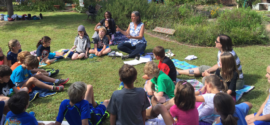
Case Study – How Morningside Elementary School Helps Dyslexic Students Succeed
Teacher training and a well-stocked toolbox help dyslexic students succeed at one Atlanta public school.
Read MoreDyslexia and Civil Rights: Making Room on the Bus for All Children
My early experiences have become my bridge to understanding dyslexia and the plight of students whose strengths go unnoticed in the classroom.
Read More
How speech-to-text transformed a student’s 5th grade year
Last fall, the fifth graders in my class were the lucky recipients of iPads–one for each student.
Read More
Rand Center: A Commitment to Accommodations
“Dyslexia robs a person of time; accommodations return it.” Dr. Sally Shaywitz
Read More